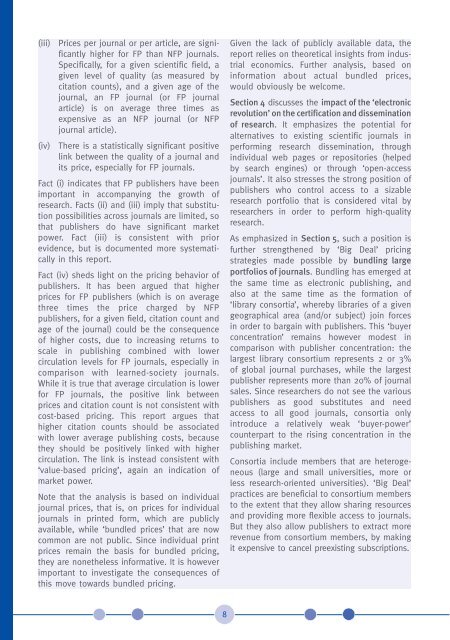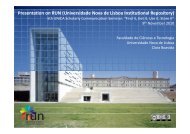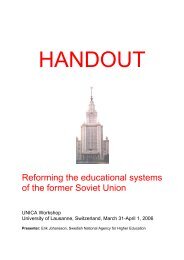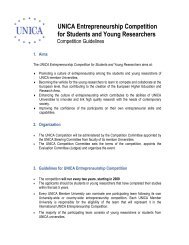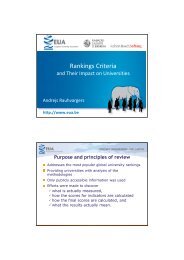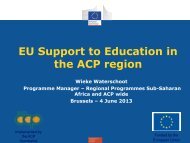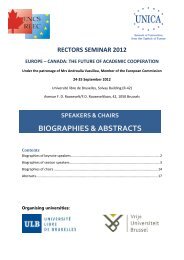Study on the economic and technical evolution of the scientific ...
Study on the economic and technical evolution of the scientific ...
Study on the economic and technical evolution of the scientific ...
Create successful ePaper yourself
Turn your PDF publications into a flip-book with our unique Google optimized e-Paper software.
(iii) Prices per journal or per article, are significantly<br />
higher for FP than NFP journals.<br />
Specifically, for a given <strong>scientific</strong> field, a<br />
given level <strong>of</strong> quality (as measured by<br />
citati<strong>on</strong> counts), <strong>and</strong> a given age <strong>of</strong> <strong>the</strong><br />
journal, an FP journal (or FP journal<br />
article) is <strong>on</strong> average three times as<br />
expensive as an NFP journal (or NFP<br />
journal article).<br />
(iv) There is a statistically significant positive<br />
link between <strong>the</strong> quality <strong>of</strong> a journal <strong>and</strong><br />
its price, especially for FP journals.<br />
Fact (i) indicates that FP publishers have been<br />
important in accompanying <strong>the</strong> growth <strong>of</strong><br />
research. Facts (ii) <strong>and</strong> (iii) imply that substituti<strong>on</strong><br />
possibilities across journals are limited, so<br />
that publishers do have significant market<br />
power. Fact (iii) is c<strong>on</strong>sistent with prior<br />
evidence, but is documented more systematically<br />
in this report.<br />
Fact (iv) sheds light <strong>on</strong> <strong>the</strong> pricing behavior <strong>of</strong><br />
publishers. It has been argued that higher<br />
prices for FP publishers (which is <strong>on</strong> average<br />
three times <strong>the</strong> price charged by NFP<br />
publishers, for a given field, citati<strong>on</strong> count <strong>and</strong><br />
age <strong>of</strong> <strong>the</strong> journal) could be <strong>the</strong> c<strong>on</strong>sequence<br />
<strong>of</strong> higher costs, due to increasing returns to<br />
scale in publishing combined with lower<br />
circulati<strong>on</strong> levels for FP journals, especially in<br />
comparis<strong>on</strong> with learned-society journals.<br />
While it is true that average circulati<strong>on</strong> is lower<br />
for FP journals, <strong>the</strong> positive link between<br />
prices <strong>and</strong> citati<strong>on</strong> count is not c<strong>on</strong>sistent with<br />
cost-based pricing. This report argues that<br />
higher citati<strong>on</strong> counts should be associated<br />
with lower average publishing costs, because<br />
<strong>the</strong>y should be positively linked with higher<br />
circulati<strong>on</strong>. The link is instead c<strong>on</strong>sistent with<br />
‘value-based pricing’, again an indicati<strong>on</strong> <strong>of</strong><br />
market power.<br />
Note that <strong>the</strong> analysis is based <strong>on</strong> individual<br />
journal prices, that is, <strong>on</strong> prices for individual<br />
journals in printed form, which are publicly<br />
available, while ‘bundled prices’ that are now<br />
comm<strong>on</strong> are not public. Since individual print<br />
prices remain <strong>the</strong> basis for bundled pricing,<br />
<strong>the</strong>y are n<strong>on</strong>e<strong>the</strong>less informative. It is however<br />
important to investigate <strong>the</strong> c<strong>on</strong>sequences <strong>of</strong><br />
this move towards bundled pricing.<br />
Given <strong>the</strong> lack <strong>of</strong> publicly available data, <strong>the</strong><br />
report relies <strong>on</strong> <strong>the</strong>oretical insights from industrial<br />
ec<strong>on</strong>omics. Fur<strong>the</strong>r analysis, based <strong>on</strong><br />
informati<strong>on</strong> about actual bundled prices,<br />
would obviously be welcome.<br />
Secti<strong>on</strong> 4 discusses <strong>the</strong> impact <strong>of</strong> <strong>the</strong> ‘electr<strong>on</strong>ic<br />
revoluti<strong>on</strong>’ <strong>on</strong> <strong>the</strong> certificati<strong>on</strong> <strong>and</strong> disseminati<strong>on</strong><br />
<strong>of</strong> research. It emphasizes <strong>the</strong> potential for<br />
alternatives to existing <strong>scientific</strong> journals in<br />
performing research disseminati<strong>on</strong>, through<br />
individual web pages or repositories (helped<br />
by search engines) or through ‘open-access<br />
journals’. It also stresses <strong>the</strong> str<strong>on</strong>g positi<strong>on</strong> <strong>of</strong><br />
publishers who c<strong>on</strong>trol access to a sizable<br />
research portfolio that is c<strong>on</strong>sidered vital by<br />
researchers in order to perform high-quality<br />
research.<br />
As emphasized in Secti<strong>on</strong> 5, such a positi<strong>on</strong> is<br />
fur<strong>the</strong>r streng<strong>the</strong>ned by ‘Big Deal’ pricing<br />
strategies made possible by bundling large<br />
portfolios <strong>of</strong> journals. Bundling has emerged at<br />
<strong>the</strong> same time as electr<strong>on</strong>ic publishing, <strong>and</strong><br />
also at <strong>the</strong> same time as <strong>the</strong> formati<strong>on</strong> <strong>of</strong><br />
‘library c<strong>on</strong>sortia’, whereby libraries <strong>of</strong> a given<br />
geographical area (<strong>and</strong>/or subject) join forces<br />
in order to bargain with publishers. This ‘buyer<br />
c<strong>on</strong>centrati<strong>on</strong>’ remains however modest in<br />
comparis<strong>on</strong> with publisher c<strong>on</strong>centrati<strong>on</strong>: <strong>the</strong><br />
largest library c<strong>on</strong>sortium represents 2 or 3%<br />
<strong>of</strong> global journal purchases, while <strong>the</strong> largest<br />
publisher represents more than 20% <strong>of</strong> journal<br />
sales. Since researchers do not see <strong>the</strong> various<br />
publishers as good substitutes <strong>and</strong> need<br />
access to all good journals, c<strong>on</strong>sortia <strong>on</strong>ly<br />
introduce a relatively weak ‘buyer-power’<br />
counterpart to <strong>the</strong> rising c<strong>on</strong>centrati<strong>on</strong> in <strong>the</strong><br />
publishing market.<br />
C<strong>on</strong>sortia include members that are heterogeneous<br />
(large <strong>and</strong> small universities, more or<br />
less research-oriented universities). ‘Big Deal’<br />
practices are beneficial to c<strong>on</strong>sortium members<br />
to <strong>the</strong> extent that <strong>the</strong>y allow sharing resources<br />
<strong>and</strong> providing more flexible access to journals.<br />
But <strong>the</strong>y also allow publishers to extract more<br />
revenue from c<strong>on</strong>sortium members, by making<br />
it expensive to cancel preexisting subscripti<strong>on</strong>s.<br />
8


